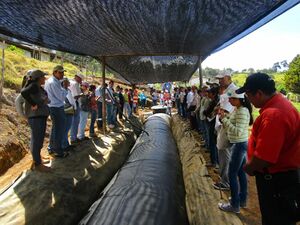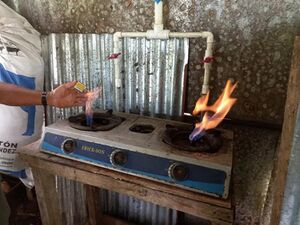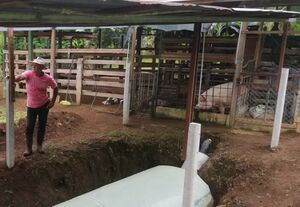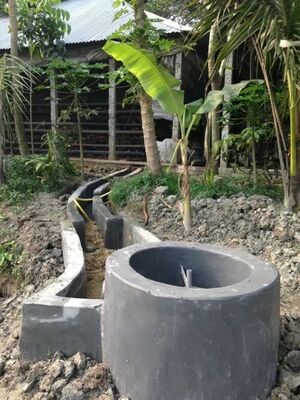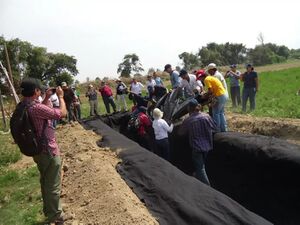Knowledge fuels change - Support energypedia!
For over 10 years, energypedia has been connecting energy experts around the world — helping them share knowledge, learn from each other, and accelerate the global energy transition.
Today, we ask for your support to keep this platform free and accessible to all.
Even a small contribution makes a big difference! If just 10–20% of our 60,000+ monthly visitors donated the equivalent of a cup of coffee — €5 — Energypedia would be fully funded for a whole year.
Is the knowledge you’ve gained through Energypedia this year worth €5 or more?
Your donation keeps the platform running, helps us create new knowledge products, and contributes directly to achieving SDG 7.
Thank you for your support, your donation, big or small, truly matters!
Domestic Biodigesters for Cooking – Silver Bullet or Failure?
Clean energy for cooking is a pressing issue: not only for achieving universal energy access by 2030, but also for preventing the 3.2 million premature deaths per year caused by the acrid smoke from polluting cooking fuels and technologies (WHO 2022). Household energy use also has its part to play in achieving net zero by 2050. As a very clean burning fuel, biogas could play an important role in this transition. According to the International Energy Agency (IEA), Africa currently has the potential to provide nearly 50 Mtoe of locally produced biogas, mainly via household-scale biodigesters. This is equivalent to almost 10% of the biomass used for traditional cooking and heating in 2021, mainly in Africa and Asia. It is also comparable to the energy consumption of Belgium (51 Mtoe in 2022) and 10 times the energy consumption of Tanzania (ca. 5 Mtoe in 2021). Moreover, by 2040, this potential could double to almost 100 Mtoe (IEA 2020).
So, do domestic biodigesters have a bright future ahead of them?
Despite these promising outlooks, the topic of biogas in the field of clean cooking doesn’t seem to be receiving the attention it deserves.
Maybe there is a certain “fatigue”, as projects promoting the technology over the last two decades have revealed significant constraints to the diffusion of domestic biodigesters. Biodigesters were often promoted as an “easy” technology, but this doesn’t tell the whole story. Not only can access to finance, water, manure and land be challenging, but poor user management and the lack of maintenance and repair services have led to malfunctioning systems and eventual abandonment in many cases. Research in East Africa found that more than 25% of the biodigesters installed between 2009 and 2013 were out of operation by 2016 (Clemens et al., 2018).
This leads us to the crucial questions: what are the success factors for biodigester programmes? What steps should be taken to ensure that biodigesters fulfil their potential?
From our research at the Wuppertal Institute, we know that taking a systems perspective helps to identify the factors that determine the success or failure of the introduction of new technologies to improve livelihoods of rural households (Ortiz et al., 2017).
The introduction of a biodigester into a rural household not only requires the adoption of a new stove and fuel, but also necessitates changes in other areas of the family farming system. This interaction between the user family, the biodigester, the farm setting and the socio-economic context of the family determines how the new technology will be used and how it will impact on livelihoods.
In our in-depth analysis of 23 studies from different countries and continents, we identified six subsystems that are relevant for the successful diffusion of domestic biogas:
- Animal Husbandry
- Crop Production
- Cooking
- Promotion and Education
- Finance
- Technology Supply
The detailed analysis shows that the introduction of biodigesters challenges the functionality of these subsystems. For instance, the type and number of animals, the feed and the type of stable or grazing practices are key determinants for biogas production and can be a supporting or hindering factor.
Moreover, the proper operation of the biodigester is more likely if its inflow is directly connected to the stables’ wastewater channels, thereby feeding the biodigester “automatically” when the stables are being cleaned. However, if a family farm generally lets its animal graze freely, adopting a biodigester requires them to introduce new daily animal husbandry practices (which reduces the likelihood of long-term adoption of the technology). Even if stables are already used, their condition might not be appropriate and investment might be required to improve the grounds, the wastewater channels and install separators for solid particles.
Regarding the crop production subsystem, the use of effluents as fertilisers is one of the most valuable benefits offered by the technology. However, this depends on the ability to properly store the effluent and transport it to the crops, which often requires not only additional investment but also adjustments to the family’s usual crop management practices. Moreover, knowledge about how and when to apply the effluents to different crops would help families to improve their yields and avoid costly errors (e.g., damaging crops by applying the effluent incorrectly).
The need to change cooking habits, as well as the seasonality of biogas in cold regions or at times of the year when anaerobic digestion is not fully operational – and the resulting fuel stacking – are also key issues to consider.
Another important determinant for the adoption and diffusion of the technology is the ability of users to access resources beyond their own households. Access to information, to skilled suppliers and to finance are necessary prerequisites for successful long-term dissemination. For instance, in terms of promotion of the technology, families need to be made fully aware not only of its benefits but also of the effort and necessary changes required before they can make an informed decision to install a biodigester. The technology needs to fit their lifestyle.
Post-installation technical support is also key for ensuring the longevity of the systems and for successful adoption of the technology. The initial installation is only the first step in a longer transformative process of the family farming system. Only once the technology is installed and the biochemical process has started do the user families face the real challenges in the operation and maintenance of the biodigesters. Regular technical assistance to ensure that users can learn how to overcome those challenges during the first months of operation is key for promoting sustainable adoption.
Finally, our research suggests that most promotion programmes have focused too much on biogas (i.e., as a cooking energy solution), overlooking the multifunctionality of the technology. Biodigesters should be seen as tools for strengthening the sustainability of family farming systems, as they can appropriately treat organic residues, reduce the contamination of water and soil, close the loop of material flows within the farm, supply biofertiliser for crops and provide clean energy, for cooking and for other uses.
It seems to us that the promotion of domestic biodigesters should become an integral part of broader programmes aiming to strengthen the livelihoods of farming families (or, at the very least, there should be some collaboration with such programmes), so that measures are planned and undertaken to integrate the technology with all relevant subsystems of the household (not limited only to the cooking subsystem).
The promotion of domestic biodigesters must therefore adopt a more holistic and systemic perspective if it is to fully exploit their potential for improving the living conditions of rural families. Only then will biodigesters have a bright and impactful future ahead of them.
Further Information
- WISIONS of sustainability an initiative by the Wuppertal Institute
- Understanding the diffusion of domestic biogas technologies. Systematic conceptualisation of existing evidence from developing and emerging countries. In: Renewable and Sustainable Energy Reviews; Volume 74, July 2017.
- Biogas portal on energypedia
- Cooking energy portal on energypedia

